非谓语动词讲解(超全)95231
超详细非谓语动词讲解
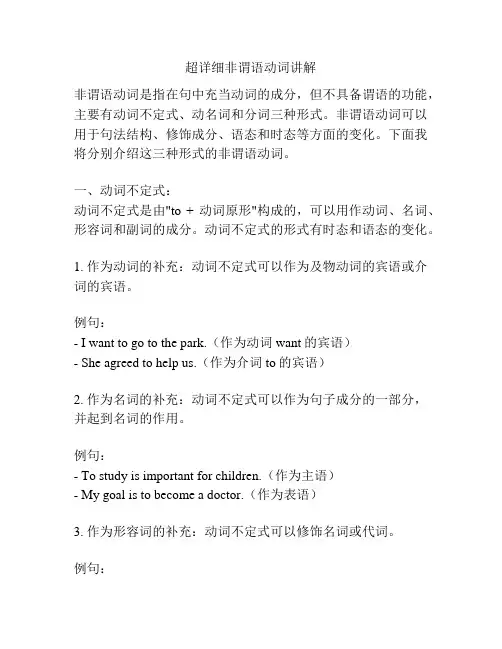
超详细非谓语动词讲解非谓语动词是指在句中充当动词的成分,但不具备谓语的功能,主要有动词不定式、动名词和分词三种形式。
非谓语动词可以用于句法结构、修饰成分、语态和时态等方面的变化。
下面我将分别介绍这三种形式的非谓语动词。
一、动词不定式:动词不定式是由"to + 动词原形"构成的,可以用作动词、名词、形容词和副词的成分。
动词不定式的形式有时态和语态的变化。
1. 作为动词的补充:动词不定式可以作为及物动词的宾语或介词的宾语。
例句:- I want to go to the park.(作为动词want的宾语)- She agreed to help us.(作为介词to的宾语)2. 作为名词的补充:动词不定式可以作为句子成分的一部分,并起到名词的作用。
例句:- To study is important for children.(作为主语)- My goal is to become a doctor.(作为表语)3. 作为形容词的补充:动词不定式可以修饰名词或代词。
例句:- I have a book to read.(修饰名词book)- She needs someone to help her.(修饰代词someone)4. 作为副词的补充:动词不定式可以修饰动词、形容词或副词。
例句:- He came here to visit his parents.(修饰动词came)- The coffee is too hot to drink.(修饰形容词hot)二、动名词:动名词是由动词的现在分词形式构成的名词,具有名词的特点,可以作为主语、宾语、表语、定语和同位语等。
1. 作为主语:动名词可以作为句子的主语。
例句:- Dancing is her favorite hobby.2. 作为宾语:动名词可以作为及物动词的宾语。
例句:- He enjoys swimming in the sea.3. 作为表语:动名词可以作为系动词的表语。
非谓语动词用法精讲(完整版)

2.不定式作宾语
一般情况下不定式都要to ,help可要可不 要;不定式有它自己的补语,要用it 作形式宾 语。
You needn't bother to come yourself.
They are considering what to do next.
Some who were famous in their own times
You can’t allow him to do that.
My advisor encouraged_____ a summer course to
improve my writing skills.
A. for me taking C. for me to take
等成分。
精品PPT
精品PPT
非谓语动词的形式变化
1、不定式相当于名词、形容词、副词。 充当主语、宾语、定语、表语、宾语补足 语、状语。 2、动名词相当于名词充当主语、表语、 定语、宾语。 3、分词相当于形容词、副词。作表语、 定语、宾语补足语、状语形成分
4、语态:必须搞清逻辑主语与非谓语动 词的关系,从而来确定非谓语动词的语态。
比 较 It is good of you to help me with my English.
你真好,帮助我学英语。 (强调you的特征=You are good to help me.) It is good for you to give up smoking.
戒烟对你有好处。 (强调的是give up smoking这一行为= For you to give up smoking is good.)
The meeting to be held tomorrow is very important.
超详细非谓语动词讲解精编版
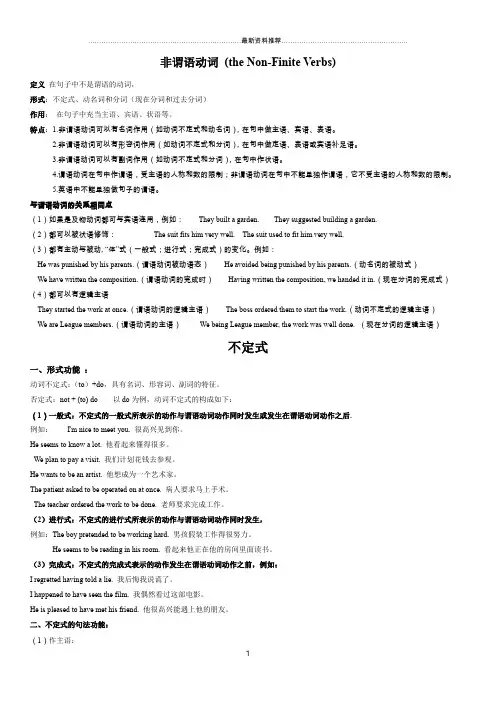
非谓语动词(the Non-Finite Verbs)定义在句子中不是谓语的动词,形式:不定式、动名词和分词(现在分词和过去分词)作用:在句子中充当主语、宾语、状语等。
特点:1.非谓语动词可以有名词作用(如动词不定式和动名词),在句中做主语、宾语、表语。
2.非谓语动词可以有形容词作用(如动词不定式和分词),在句中做定语、表语或宾语补足语。
3.非谓语动词可以有副词作用(如动词不定式和分词),在句中作状语。
4.谓语动词在句中作谓语,受主语的人称和数的限制;非谓语动词在句中不能单独作谓语,它不受主语的人称和数的限制。
5.英语中不能单独做句子的谓语。
与谓语动词的关系相同点(1)如果是及物动词都可与宾语连用,例如:They built a garden. They suggested building a garden.(2)都可以被状语修饰:The suit fits him very well. The suit used to fit him very well.(3)都有主动与被动, “体”式(一般式;进行式;完成式)的变化。
例如:He was punished by his parents.(谓语动词被动语态)He avoided being punished by his parents.(动名词的被动式)We have written the composition.(谓语动词的完成时)Having written the composition, we handed it in.(现在分词的完成式)(4)都可以有逻辑主语They started the work at once.(谓语动词的逻辑主语)The boss ordered them to start the work.(动词不定式的逻辑主语)We are League members.(谓语动词的主语)We being League member, the work was well done. (现在分词的逻辑主语)不定式一、形式功能:动词不定式:(to)+do,具有名词、形容词、副词的特征。
中学英语非谓语动词讲解
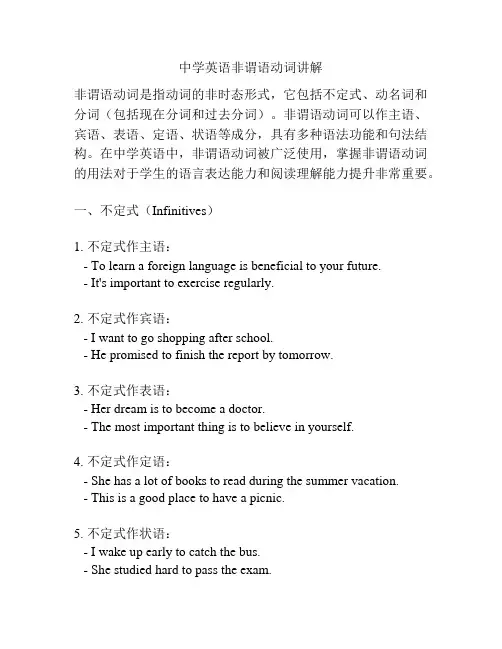
中学英语非谓语动词讲解非谓语动词是指动词的非时态形式,它包括不定式、动名词和分词(包括现在分词和过去分词)。
非谓语动词可以作主语、宾语、表语、定语、状语等成分,具有多种语法功能和句法结构。
在中学英语中,非谓语动词被广泛使用,掌握非谓语动词的用法对于学生的语言表达能力和阅读理解能力提升非常重要。
一、不定式(Infinitives)1. 不定式作主语:- To learn a foreign language is beneficial to your future.- It's important to exercise regularly.2. 不定式作宾语:- I want to go shopping after school.- He promised to finish the report by tomorrow.3. 不定式作表语:- Her dream is to become a doctor.- The most important thing is to believe in yourself.4. 不定式作定语:- She has a lot of books to read during the summer vacation.- This is a good place to have a picnic.5. 不定式作状语:- I wake up early to catch the bus.- She studied hard to pass the exam.二、动名词(Gerunds)1. 动名词作主语:- Swimming is my favorite sport.- Dancing helps improve coordination.2. 动名词作宾语:- She enjoys reading novels.- He hates doing the dishes.3. 动名词作表语:- His hobby is playing the piano.- The key to success is working hard.4. 动名词作定语:- I have a meeting with my boss tomorrow morning. - The running water sounds relaxing.5. 动名词作状语:- She left the room, crying loudly.- He drove to work, listening to music.三、分词(Participles)1. 现在分词作定语:- The exciting movie kept us on the edge of our seats. - The running boy bumped into a lady.2. 现在分词作状语:- Smiling happily, she accepted the gift.- With his homework finished, he went to bed.3. 过去分词作定语:- The broken chair needs to be repaired.- The lost dog was found by its owner.4. 过去分词作状语:- Inspired by her teacher, she decided to pursue a career in art.- Exhausted from the long journey, they went straight to bed.总结起来,中学英语非谓语动词的用法主要包括不定式、动名词和分词。
非谓语动词讲解整理
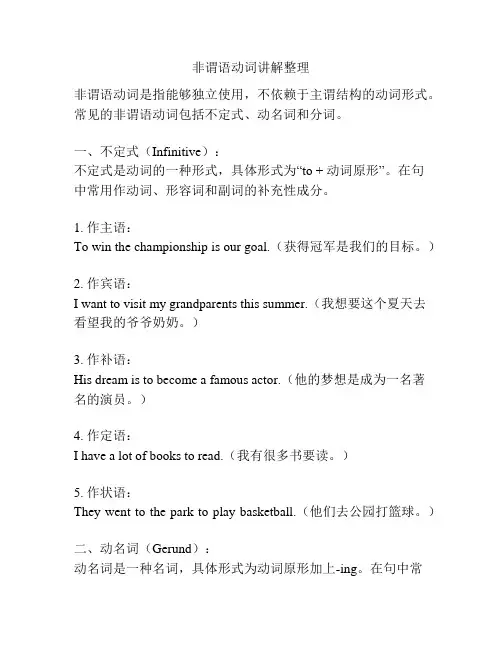
非谓语动词讲解整理非谓语动词是指能够独立使用,不依赖于主谓结构的动词形式。
常见的非谓语动词包括不定式、动名词和分词。
一、不定式(Infinitive):不定式是动词的一种形式,具体形式为“to + 动词原形”。
在句中常用作动词、形容词和副词的补充性成分。
1. 作主语:To win the championship is our goal.(获得冠军是我们的目标。
)2. 作宾语:I want to visit my grandparents this summer.(我想要这个夏天去看望我的爷爷奶奶。
)3. 作补语:His dream is to become a famous actor.(他的梦想是成为一名著名的演员。
)4. 作定语:I have a lot of books to read.(我有很多书要读。
)5. 作状语:They went to the park to play basketball.(他们去公园打篮球。
)二、动名词(Gerund):动名词是一种名词,具体形式为动词原形加上-ing。
在句中常用作名词的主语、宾语和表语。
1. 作主语:Swimming is one of my favorite hobbies.(游泳是我最喜欢的爱好之一。
)2. 作宾语:She enjoys playing the piano.(她喜欢弹钢琴。
)3. 作表语:His job is teaching English.(他的工作是教英语。
)4. 作定语:I saw a girl carrying a basket of flowers.(我看到了一个拿着一篮花的女孩。
)5. 作状语:He left the house, crying loudly.(他大声哭着离开了房子。
)三、分词(Participle):分词是动词的一种形式,分为现在分词(-ing形式)和过去分词(-ed、-en等形式)。
在句中常用作形容词和分词短语的修饰成分。
(完整版)初中英语非谓语动词讲解.doc
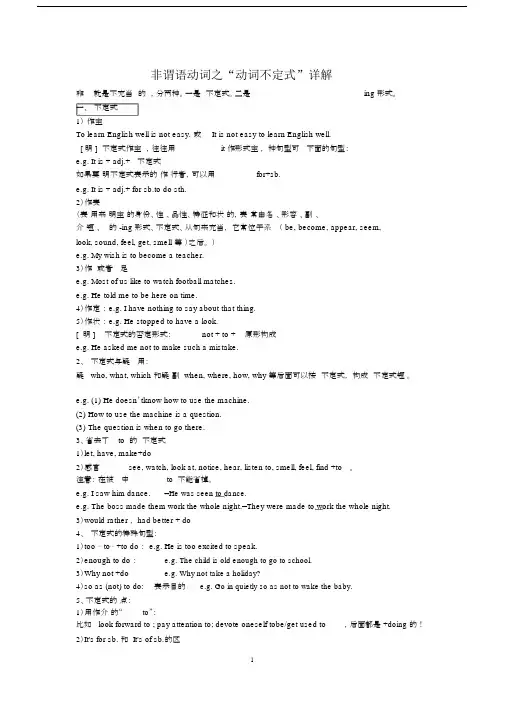
非谓语动词之“动词不定式”详解非就是不充当的,分两种。
一是不定式。
二是ing 形式。
一、不定式1)作主To learn English well is not easy. 或It is not easy to learn English well.[明 ]不定式作主,往往用it 作形式主,种句型可下面的句型:e.g. It is + adj.+ 不定式如果要明不定式表示的作行者,可以用for+sb.e.g. It is + adj.+ for sb.to do sth.2)作表(表用来明主的身份、性、品性、特征和状的,表常由名、形容、副、介短、的 -ing 形式、不定式、从句来充当,它常位于系( be, become, appear, seem,look, sound, feel, get, smell 等)之后。
)e.g. My wish is to become a teacher.3)作或者足e.g. Most of us like to watch football matches.e.g. He told me to be here on time.4)作定: e.g. I have nothing to say about that thing.5)作状: e.g. He stopped to have a look.[ 明 ] 不定式的否定形式:not + to + 原形构成e.g. He asked me not to make such a mistake.2、不定式与疑用:疑 who, what, which 和疑副 when, where, how, why 等后面可以按不定式,构成不定式短。
e.g. (1) He doesn’tknow how to use the machine.(2)How to use the machine is a question.(3)The question is when to go there.3、省去了to 的不定式1)let, have, make+do2)感官see, watch, look at, notice, hear, listen to, smell, feel, find +to。
(完整word版)非谓语动词讲解
非谓语动词【知识要点】定义:在英语中,不作句子谓语,而具有除谓语外其他语法功能的动词,叫做非谓语动词。
分类:非谓语动词有动词不定式(the Infinitive);动名词(the Gerund);现在分词(the Present Participle);过去分词(the Past Participle)。
无论它们在句中作什么成分,他们都保持着自己本身的属性特点。
动词不定式:表将来、具体某一次,常在句中可以作: 主语,宾语,定语,状语,补语,表语;动名词:具有名词功能,常在句中可以作:主语,宾语,表语;作定语时表功能;现在分词:表主动和正在进行, 常在句中可以作: 定语,状语,表语,宾补;过去分词:表被动和已完成,常在句中可以作: 定语,状语,补语。
一、动词不定式不定式由“to+动词原形”构成,其否定形式是“not to+动词原形”。
不定式可以带宾语或状语构成不定式短语,没有人称和数的变化,但有时态和语态的变化。
不定式可作主语、宾语、状语、表语、定语和补语,但不能单独作谓语。
2. 不定式的句法功能1)作主语:To finish the work in ten minutes is very hard.在十分钟内完成这项工作很难。
动词不定式短语作主语时,常用it作形式主语,例如上面一句可用如下形式:It is very hard to finish the work in ten minutes.2)作表语:Her job is to clean the hall.她的工作就是打扫大厅。
3)作宾语:V.+ to do sth.常与不定式作宾语连用的动词有:want, hope, wish, offer, fail, plan, learn, pretend, refuse, manage, help, agree, promise, prefer,afford,ask,decide,expect,intend,等。
非谓语动词讲义
非谓语动词讲义一、非谓语动词定义在英语中,不能作句子谓语,而是担任其他语法功能的动词,叫作非谓语动词。
二、非谓语动词形式及其功能非谓语动词有3种形式:动词不定式,动名词和分词(含现在分词和过去分词)。
三.根据语法功能看非谓语动词的用法(一)作主语懂一点英语是一回事,掌握英语完全是另一回事。
通常用it做形式主语1.It + be + adj. + to do It’s important for us to learn English.2.It + be + n. + to do It’s a shame to behave like that.3.It + v. + (宾语) + to do It takes an exceptional teacher to cope with astudent like that.4.It + be + prep. phr. + to do It is not within my power to answer thequestion.通常用it做形式主语1.It’s +adj. +doing It’s useless arguing about that.2.It’s + n. + doing It’s no use/no good arguing about3.There is后有时可以跟动名词做主语There is no denying that he isbad-tempered.动名词:表示客观性、一般性行为不定式:表示一次性、具体性行为(见ppt)(二)作宾语决心学会想希望,decide/determine, learn, want, expect/hope/wish,拒绝设法愿假装。
refuse, manage, care, pretend主动应答选计划,offer, promise, choose, plan同意请求帮一帮。
agree, ask/ beg, help此外,afford, strive(努力)等也要不定式作宾语。
非谓语动词讲解史上最全
非谓语动词讲解史上最全非谓语动词是英语中的一种特殊动词形式,它们在句子中通常不具备时态和人称的变化。
非谓语动词包括不定式、动名词和现在分词。
一、不定式(Infinitive)不定式由to加动词原形构成,具有动词和名词的双重特征。
不定式在句子中可以作主语、宾语、表语、定语、状语等成分。
1. 作主语:To learn a foreign language is beneficial to your career.学习一门外语对你的事业有益。
2. 作宾语:I want to visit my grandparents this weekend.我想这周末去看望我的祖父母。
3. 作表语:His dream is to become a famous writer.他的梦想是成为一名著名的作家。
4. 作定语:She has many books to read.她有很多书要读。
5. 作状语:He came to help us.他来帮助我们。
二、动名词(Gerund)动名词由动词原形加-ing构成,具有动词和名词的双重特征。
动名词在句子中可以充当主语、宾语、表语、定语、状语等成分。
1. 作主语:Swimming is my favorite sport.游泳是我最喜欢的运动。
2. 作宾语:I enjoy reading novels in my free time.我喜欢在空闲时间读小说。
3. 作表语:Her hobby is singing.她的爱好是唱歌。
4. 作定语:The running water is clear.流动的水很清澈。
5. 作状语:She went shopping after finishing her homework.她在完成作业后去购物。
三、现在分词(Present Participle)现在分词由动词原形加-ing构成,具有动词和形容词的双重特征。
现在分词在句子中可以充当定语、表语、状语等成分。
非谓语动词讲解全讲解
非谓语动词讲解全讲解非谓语动词是指不具备主谓关系的动词形式,它不受主语限制,可以独立存在,并且在句子中起到修饰、补充、缩略或做其他动词的功能。
非谓语动词主要有不定式、动名词和分词三种形式。
一、不定式(Infinitive)1. 不定式作主语例句:To learn a foreign language is challenging but rewarding.学一门外语既具有挑战性又有回报。
2. 不定式作宾语a)及物动词后的不定式作宾语,通常前有动词to。
例句:She wants to visit her parents this weekend.她希望这个周末去看望她的父母。
b)某些及物动词和短语动词后的不定式省去to。
例句:They made him clean up the mess.他们让他整理这个烂摊子。
3. 不定式作状语a)表示目的、原因或结果。
例句:She studies hard to pass the exam.她努力学习为了通过考试。
b)表示时间或条件。
例句:I woke up early to catch the first train.我早起为了赶上第一班火车。
二、动名词(Gerund)1. 动名词作主语例句:Swimming is good exercise.游泳是很好的锻炼。
2. 动名词作宾语a)动名词作宾语,通常前面有动词stop、enjoy、dislike、suggest等。
例句:I enjoy reading books in my spare time.我喜欢在闲暇时间读书。
b)动名词作宾语,有时可以用不定式作宾语来替代,意思有所差别。
例句:I like swimming.(动名词作宾语,表示一种习惯或爱好)I like to swim.(不定式作宾语,表示一次性的行为)3. 动名词作定语例句:Do you have any interesting stories to share?你有什么有趣的故事可以分享吗?三、分词(Participle)1. 现在分词(-ing形式)作定语例句:The running dog caught my attention.奔跑的狗引起了我的注意。
- 1、下载文档前请自行甄别文档内容的完整性,平台不提供额外的编辑、内容补充、找答案等附加服务。
- 2、"仅部分预览"的文档,不可在线预览部分如存在完整性等问题,可反馈申请退款(可完整预览的文档不适用该条件!)。
- 3、如文档侵犯您的权益,请联系客服反馈,我们会尽快为您处理(人工客服工作时间:9:00-18:30)。
非谓语动词讲解非谓语动词: a.动词不定式 b.动名词 c.分词( 现在分词过去分词)概述:1.谓语动词:在句子中担任谓语的动词2.非谓语动词:是动词的特殊形式,在句中可以作除谓语外的所有成分非谓语动词使用条件一个句子当中,已经存在一个主句(谓语动词),又没有连词的情况下, 还有别的动词出现时。
She got off the bus, leaving her handbag on her seat.She got off the bus, but left her handbag on her seat.动词不定式一.动词不定式的时态和被动形式动词不定式是非谓语动词的一种,由不定式符号(to)加动词原形构成。
不定式的形式有五种:1.一般式to do 例如:I like to read English.2.进行式to be doing 例如:He seemed to be reading something at that time.3.完成式to have done 例如:He seemed to have cleaned the room.4.被动式to be done 例如:The work is to be done soon.5.完成被动式to have been done例如:The boy is said to have been sent to hospital yesterday.二. 动词不定式的用法I.作主语(1)不定式做主语时,可以直接放在谓语动词之前。
To see is to believe.Not to get there in time is your fault.(2)注:常用it做形式主语,将to do放在位于之后,使句子保持平衡。
句型1:It + 谓语+ to do It takes us an hour _to__ get there by bus.句型2:It’s + n. + to do It’s our duty _to_ help the poor.It is a great enjoyment _to_ spend our holiday in the mountains.句型3:It is + adj + for sb to do sth(是形容事物的性质的)It is + adj + of sb to do sth(是形容人的品质的)It is easy for me to finish this work before ten.It is a great honor for us to be present at your birthday party.It is very kind of you to give me some help.It's impolite of you to speak to the teacher like that.II.作宾语接不定式做宾语I want to know this matter.I don’t expect to meet you here(1)常见动词有:like, demand, expect, promise, begin, determine, refuse, offer, fail, manage,learn, seem, intend, forget, want, prepare, pretend, refuse, plan, afford, wish等They wanted _to get___( get ) on the bus, didn’t they? He said he wished __to be____( be )a professor.(2)it作形式宾语I find/feel to work with him interesting .I find/feel it interesting to work with him.Subject+ find/think/feel/make/ consider…it+adj/n + to do sth.1.We thought _it__ better __to_ start early.2.Do you consider _it__ better not _to_ go?3. I feel _it_ my duty _to_ change all that.4.We think it __ important _ to _ obey thelaw.5.I know _ it _ impossible _ to _ finish so much homework in a day.(3)常跟疑问词+不定式作宾语的动词:tell, advise, show, teach, find out, decide, discuss, learn, explain, know, discover, He taught us how to use the tool. No one could tell me where to get the book.I haven't decided whether to go or stay.下列词接动名词和不定式均可,但意义不同的动词:stop to do 停下来去做stop doing 停止做forget to do 忘记要做forget doing 忘记做过remember to do 记得要做remember doing 记得做过regret to do 遗憾要做regret doing 后悔做过try to do 企图做,尽力做try doing 试着做go on to do 继续做(另一件事)go on doing 继续做(同一件事)mean to do 打算做mean doing 意味做In some parts of London, missing a bus means _A______ for another hour.A waitingB to waitingC waitD to be waitingBoys, don't forget _D____ the windows before you leave the classroom.A. closingB. closedC. to closingD. to closeShe reached the top of the hill and stopped __C_____ on a big rock.A. to have restedB. restingC. to restD. restRemember _A______ the lights when you leave the office.A. to turn offB. turning offC. turn offD. to turning off(4)在cannot but, cannot choose/help but 之后接不带to的不定式I have no choice but __to wait_____.(wait)“前有do,后无to”I can’t do anything but _go______ (go )out with her.III.作宾语补足语1. I’ll get someone _to__ repair the recorder for you.2. What caused him _to__ change his mind?advise, allow, ask, beg, cause, expect, encourage, force, get, hate, invite , order, wish , want, warn, remind, promise, permit, persuade, request+sb. to do注意:(1)在动词feel (一感),hear, listen to(二听),have, let, make(三让),notice, see, watch, observe, look at(五看)(即:吾看三室两厅一感觉)等后面的补足语中,不定式不带to,但变为被动语态后,必须带to。
如:They saw the boy fall off the tree.The boy was seen to fall off the tree.(2)help后面作宾语补足语的不定式可以带to,也可以不带to.I often help him (to)clean the room. I helped him (to) find his things.He is often heard _to sing_______(sing) the song.Though he often made his deskmate _cry_____(cry), today he was made __to cry__(cry) by his deskmate.IV.作定语I have something to tell you. (不定式作定语)1)不定式与它所修饰的词有动宾关系Do you have anything to wash today?2)不定式用来说明所修饰词的内容I have no chance to go there.3)被修饰词是不定式的逻辑主语She is always the last to leave the room.4)不定式为不及物动词且和所修饰的名词是动宾关系时,须加介词1.The house is not big enough for us all___A____.A. to live inB. to be lived inC. to liveD. for living in2. Would you please pass me the knife ____A___?A. to cut the fruit withB. to cut the fruitC. cutting the fruitD. cutting the fruit with3.I have something important to say. Please find a piece of paper to write on(写上)4.Excuse me,could I use your pen for a moment?I have no pen to write with(写)V.作状语不定式作状语可以表示目的、原因、结果。
